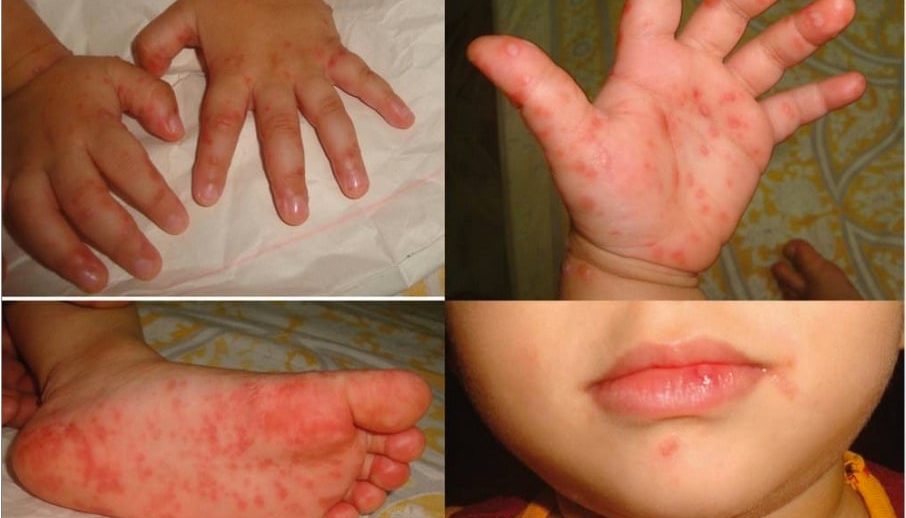Hand, Foot and Mouth Disease

HAND, FOOT AND MOUTH DISEASE
by Dr. Rebs Andal, Pediatrician
“Not all Fever with Blisters is Bulutong”
One of the most common reasons for a clinic visit is when a child develops fever accompanied with discomforts — particularly skin rashes or blisters that are not pleasing to the eye. Being in a tropical country, certain groups of viruses thrive the whole year-round. One viral infection, which is quite common nowadays, presents with fever, cold-Iike symptoms, mouth ulcers and skin rashes commonly located over hands and feet (buttocks, knees, diaper area, elbows, rarely on trunk). No, this is not the popular bulutong (chickenpox) or tigdas (measles) or bacterial skin infection that the. anxious parents initially thought their ill child has. This is a possible case of infection we call Hand, Foot, and Mouth Disease (HFMD).
Cause. HFMD is a viral infection from a group called Human Enteroviruses. The most common types are Coxsackievirus A16, A6, Al 0 and Enterovirus 71. it can spread quite easily. One way is via the usual common cold from coughing or sneezing spreading the viruses in the air through droplets. Another method of transmission is via direct contact from contaminated surfaces. These viruses can spread via fecal (stool) oral route. If there is massive infection, the viruses can still be transmitted for up to four weeks via infected stool even if the symptoms have already passed You can also get infected through direct contact with the fluid from the skin rashes/blisters or saliva.
Signs and Symptoms. HFMD is common among the younger age group; especially those below 10 years old, but can also infect adults. It is a self-limiting disease with duration of less than two weeks. lt is usually a mild illness that initially presents with respiratory symptoms like cough and colds accompanying with loss of appetite in the first few days due to development of oral ulcers, which can be painful during swallowing. Then the patient develops Iow to moderate grade fever usually on the third day onwards with appearance of reddish rash of variable spots and sizes progressing into sacs that is commonly mistaken as bulutong (chickenpox) – only smaller and less itchy. These can develop into blisters that may cause discomfort to the individual. All these symptoms are not life threatening but can be very unpleasant which makes the parents very anxious, hence their decision to seek immediate consult to a health care professional.
Treatment.
Parents should be comforted by the fact that HFMD is a self-limiting condition, which means it will get better on its own during the course of illness. The symptoms will usually subside within seven to ten days. To date, there is currently no cure for HFMD; therefore, treatment involves making your patient feel as comfortable as possible. Provide supportive care by using medicines to control fever (paracetamol, ibuprofen), mouth gels to relieve discomfort from the mouth ulcers, drink plenty of fluids to avoid dehydration, give soft foods that can easily be ingested, since swallowing can be a little painful with those ulcers in the oral cavity and taking some time off and adequate rest for a few days will be of great help for a speedy recovery. In some cases, a person with HFMD will need hospital admission due to dehydration, the refuse to drink or eat because of the painful oral ulcers. If admission is warranted, hospital infection control must be alerted to prevent further spread — health care professionals must wash their hands at all times as they attend and provide comfort to their needs.
Prevention.
Hand, foot and mouth disease can easily spread in the community, especially in crowded places. lt is everybody’s responsibility to prevent and control this contagious disease. Avoid close contact with
those who have HFMD. Always wash your hands after using the toilet, after changing diapers and before
preparing food. Children with the disease must always wash their hands frequently as they can contaminate surfaces that they touch; hence all work/play/feeding surfaces must be
clean including clothing, bed sheets, and utensils. Since this disease is contagious, infected school children must be excused from their classes while they are not feeling well. Recovery can be as short as one to two weeks.
Campaign. Hand, foot and mouth disease is contagious but preventable. Always wash your hands thoroughly. Hand foot and mouth disease is DIFFERENT from the foot and mouth disease (FMD) coming from a different virus that ONLY affects animals. For further information, your doctor in the best position to address your health-related concerns.
References:
1 .Nelson Textbook of Pedsatncs 19th Edition 2012
http://www.cdc.gov. hand-foot-mouth/ 3.htip://www_nhs.uk/Conditions/Hand-foot-and-mouthdisease/
